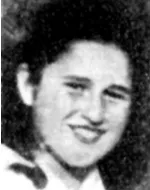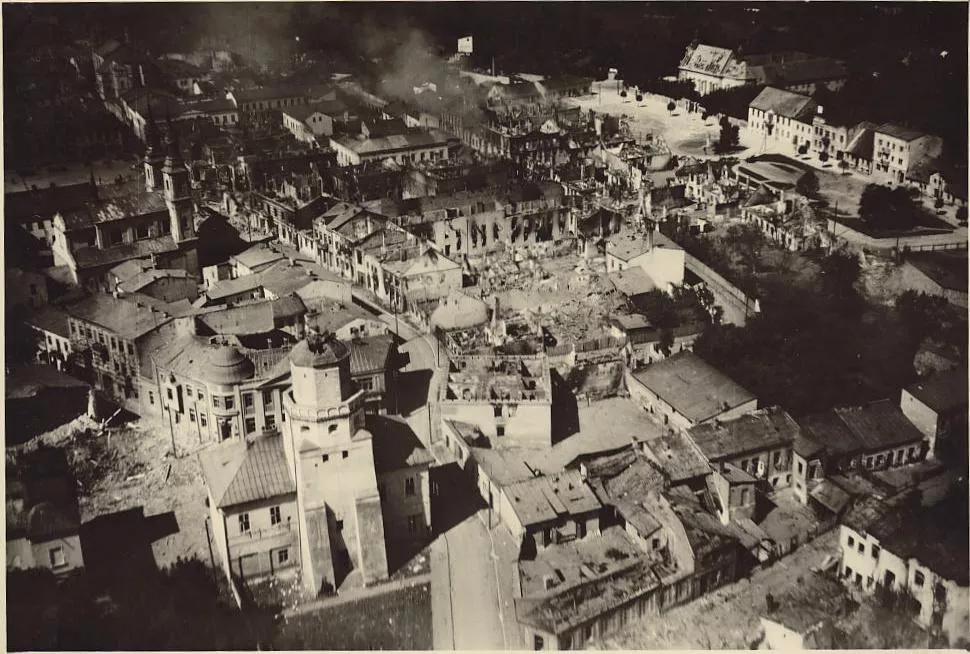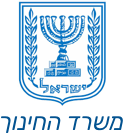Atara Abramson, May G-d Avenge her Blood
75 years since she died in santification of G-d’s Name. Iyar 4, 5708 – Iyar 4, 5783 (May 13, 1948-April 25, 2023)

The chassidic rabbi, Rabbi Avigdor Abramson, one of the Chassidim and an influential person in the town of Wielun in the Lodz district of Poland, led a warm chassidic home with his wife, Rivka.

The city center of Wielun, Poland, bombed by the German army
At the outbreak of the war, he was almost forty years old. In the testimonial page provided by his nephew, it appears that Avigdor died of starvation during the year 1942.
Both he, and his wife Rivka, like all of his children, brothers and sisters, relatives and friends, perished at the hands of the Nazis and their collaborators. The only exception was their daughter, Atara (Kreindel), a smart, God-fearing girl, full of grace and youthfulness, who at the outbreak of the war was only 13 years old.
Kreindel also faced the poisonous cup. She was deported to concentration camps in Germany and was finally imprisoned in Auschwitz, the greatest and most terrible place of death on earth, where she suffered excruciating torment, but she survived.
Kreindel experienced much suffering until she was liberated. She joined a group of illegal immigrants, and after many wanderings and physical and mental suffering, she was allowed, on Av 5, 5706 (Aug. 2, 1946), to board a ship called the “23 Seamen” (after the 23 seamen who disappeared five years earlier in an unknown activity).
The ship was discovered in the area of Cyprus and was towed by a British destroyer to Haifa and from there by force to Cyprus, where Atara-Kreindel lived with her 790 traveling companions for six months.
Only in Shvat 5707 (winter 1947), was she able to immigrate to Israel, and she immediately settled in Kfar Etzion.
With the publication of the UN resolution on November 29th, 1947 concerning the Jewish state, the surrounding Arabs began to attack Gush Etzion (where the Kfar Etzion settlement is located) and the roads leading to it, and attacked it from all sides.
For months, Kfar Etzion was under a suffocating siege, and its residents suffered repeated attacks. During these months, Atara diligently studied first aid, and soon became a medic and a kind of doctor who treated the wounded members of the besieged block, and Atara’s professional help often saved lives.
According to what is described in the Yizkor (memorial) book, Atara “showed great courage, was serious and responsible at work, alert on the spot, ready for any call, caring for the wounded with devotion and gentleness.”
Due to Gush Etzion’s control of the road connecting Hebron to Jerusalem, the Jordanian army (“the Arab Legion”) launched a fierce attack on it even before the end of the Mandate and the British exit from the country. On May 12, 1948, the soldiers of the Jordanian Legion launched a powerful attack on the bloc’s rule and managed to cut it in two. The next day, Iyar 4, 1948 (May 13, 1948), the Legion force broke through the fortifications of Kfar Etzion, followed by crowds of Arabs from the surrounding villages. The Israeli defenders were ordered to ceasefire, surrender, and concentrate near the school building. Suddenly the Arabs opened fire on the surrenderers. Some were killed, and others managed to escape to the cellar of the German monastery, from where they tried to continue fighting. The Arabs, who could not penetrate into the shelter, threw many grenades inside and finally blew up the building with its occupants inside.
The women of the village, including Atara, stayed at the first aid station in the shelter, where they served as medics. Atara was buried under the rubble of the building with the rest of its occupants.
About 130 of the defenders of Kfar Etzion fell that day. The next day, Iyar 5, 1948 (May 14, 1948), the day of the proclamation of the State, the defenders of the other three settlements of Gush Etzion surrendered: Revadim, Mesuot Yitzchak, and Ein Tzurim. On this day the Gush ceased to exist, and the surviving defenders were taken into Jordanian captivity. They were the ones who reported the death of Atara to representatives of the Red Cross.
Atara was 21 years old when she fell.
(Yizkor – Last Sion, published by the Ministry of Defence)
Atara-Kreindel, daughter of Avigdor and Rivka, is remembered at Ganzach Kiddush Hashem. A young woman who saw so much in her young life, a Holocaust survivor, saw the loss of her family, her people, and her homeland in the terrible Holocaust, and after all the suffering she experienced immigrated to the Land of Israel, where she saved Jewish souls, and established “entire worlds” (“Whoever saves one soul from the People of Israel as if he saved a whole world”). Atara, was a symbol and example in her leadership and way of life, and according to the testimony given about her (ibid., “The Last Scion”) – “Atara, had a deep religious feeling and was always careful in her serious prayer and in her caution in observing the mitzvahs” – she meritted a martyr’s death out of dedication to saving the lives of many Jewish souls.
On the 75th Yom HaZikaron (Memorial Day), we will look at Atara’s character, pray, and light a candle for the uplifting of her soul, and reflect a little on a young girl who lost her whole world in the evil years, but did not sink into grief and certainly not into resentment, and instead chose life, and was engaged in saving lives.
May her soul be bound in the bonds of life.







